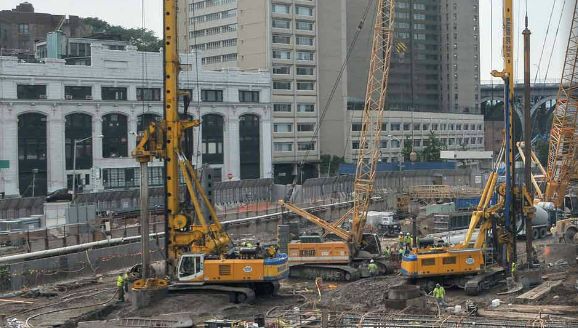Project News
E.E. Cruz Uses Top-Down Construction on Columbia University Campus Expansion

Since January 2011, E.E. Cruz has been building foundations for the Jerome L. Greene Science Center, the first part of Columbia University’s ambitious Manhattanville project, a new 17-acre campus expansion in the West Harlem neighborhood of New York City.
E.E. Cruz will build more than 150,000 square feet of watertight perimeter diaphragm wall, or slurry wall, install 96 load bearing elements, and excavate and construct the foundations and sub-basement. The site covers two city blocks and is one of the biggest digs in New York. Project manager Mark Alexander says this actually makes the work easier.

“My crew came from the World Trade Center site, so this is a lot of space for us. There we had 100 different contractors working in the same small area. We joke that we don’t know how to work with all this extra space.”
The $121 million project is a joint venture between managing partner and Flatiron subsidiary E.E. Cruz and Nicholson Construction Company.
“We’ve been working together for 12 years. We’re like brothers,” says Nicholson project superintendent Del RasMjou of his joint venture partner and counterpart Mark. “It’s a perfect partnership.”
As of late May, nearly half of the 96 load-bearing elements had been installed. Rigs are on-site drilling six-to seven-foot diameter shafts up to 240 feet into the ground below. Once a shaft is complete, a rebar cage is installed and filled with concrete. Steel beams, each weighing up to 35 tons, are mounted into column plungers and elevator beams, then carefully positioned over the shafts with large cranes. Accuracy is vital, because the beams must be positioned within three-eighths of an inch in every direction.
“The plunger and elevator beam are so critical because they allow us to line up the core beam exactly, so when you set the beam in
the concrete, it’s perfect,” says Mark.
It takes approximately a day to drill each shaft, and if everything goes according to plan, concrete is placed and the beam is set the following day. But it can take longer if the team encounters something unexpected in the drilling path.
“ We’ve had tough drilling conditions and stability issues with the holes, and we have encountered boulders and nested cobblers that have slowed the drilling process,” adds Mark.
 One unique aspect of this project is the top-down construction sequence. Once the foundation is poured, work will begin on the six-story high-rise superstructure while E.E. Cruz simultaneously excavates 100,000 cubic yards of soil 60 feet below grade and constructs two sub-basement floors.
One unique aspect of this project is the top-down construction sequence. Once the foundation is poured, work will begin on the six-story high-rise superstructure while E.E. Cruz simultaneously excavates 100,000 cubic yards of soil 60 feet below grade and constructs two sub-basement floors.
“As we dig down, the slab will be poured and we will continue to mine underneath it,” says Pat Roach, general superintendent on the project and a 14-year veteran of E.E. Cruz.
Owner Columbia University went with top-down construction because of access constraints. “In conventional excavation you’d use braces or tie backs for the walls. But you’d need 300-foot tiebacks in some places, which we can’t do here due to property line constraints,” says Mark. “Plus, they’ll build vertically while we excavate below, so it’s also a schedule saver.”
Construction in New York City presents a host of challenges for E.E. Cruz. The site is next to an active, above-ground subway line,
which complicated crane operations.
“We have to work parallel to the panels because the crane cannot be in a position to potentially damage the adjacent rail line,” advises Pat Roach. “Cranes are highly scrutinized, especially when you’re working with a long boom crane on a site like this,” says Mark.
Below ground, there are more hidden challenges for the team. Manhattanville was once a bustling industrial and manufacturing area, and more recently was occupied by warehouses and gas stations. Before slurry walls are constructed, teams excavate 18 feet from the surface to remove debris left over from previous structures, as well as contaminated soil from a previous gas station.
“There are old buildings, basement floors, basement walls—we take out tons of stuff,” says Del. The new development, of which this is just one building, will take 25 years to complete and add 6.8 million square feet of new space for teaching, academic research, parking, facilities support and commercial space.
In mid-March, the E.E. Cruz and Nicholson joint venture team was awarded a $44 million contract for phase two of the project, which involves constructing another 206,000 square feet of diaphragm wall.
